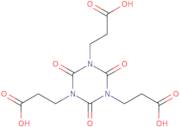Tris(2-carboxyethyl) Isocyanurate
CAS: 2904-41-8
Ref. 3D-CAA90441
| 25g | Descatalogado | ||
| 50g | Descatalogado | ||
| 100g | Descatalogado | ||
| 250g | Descatalogado | ||
| 500g | Descatalogado |
Información del producto
- 1,3,5-Triazine-1,3,5(2H,4H,6H)-tripropanoic acid, 2,4,6-trioxo-
- 1,3,5-Tris(2-carboxyethyl) isocyanurate
- 1,3,5-Tris(2-carboxyethyl)isocyanuric acid
- 1,3,5-Tris(carboxyethyl) isocyanurate
- 2,4,6-Trioxo-1,3,5-triazine-1,3,5(2H,4H,6H)-tripropanoic acid
- 3,3',3''-(2,4,6-Trioxo-1,3,5-Triazinane-1,3,5-Triyl)Tripropanoic Acid
- CIC Acid
- Hexahydro-2,4,6-trioxo-s-triazine-1,3,5-tripropionic acid
- NSC 11694
- Tri(2-Carboxyethyl)-1,3,5-Triazinetrione
- Ver más sinónimos
- Tris(2-carboxyethyl) isocyanurate
- Tris(carboxyethyl) isocyanurate
- s-Triazine-1,3,5(2H,4H,6H)-tripropionic acid, 2,4,6-trioxo-
Tris(2-carboxyethyl) isocyanurate (Tris) is a polymer that forms a monolayer on the surface of metals. This film protects the metal from corrosion and degradation, which can be caused by atmospheric gases and water. Tris has been shown to be stable in acidic environments and in the presence of metal ions. It also does not react with hydrogen chloride, which is often present in car exhausts. The crystal structure of Tris has been determined using x-ray diffraction methods, revealing a supramolecular arrangement of six molecules around one metal ion. Tris is luminescent and can serve as an indicator for the presence of p-hydroxybenzoic acid.





